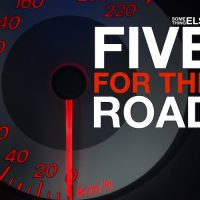As an educator in addition to long being one of the most advanced musicians in and out of jazz, Peter Erskine’s proficiency on drums is inarguably at the doctorate level. Belatedly taking up a quarter-century old suggestion from an old friend, Erskine created a ‘new’ persona of himself as the PhD-accredited linchpin for his newest album Dr. Um, out January 15, 2016 through Erskine’s own Fuzzy Music imprint.
This new persona is really the old Peter Erskine that fusion fans were attracted to from his days in Weather Report and Steps Ahead, two of the genre’s most advanced outfits. But since then, Erskine’s exploits have been predominantly on the straight ahead and egghead side of jazz (he had become a regular on ECM both as a leader and a sideman) while continuing to participate in high-profile studio dates with the likes of Barbra Streisand, Kate Bush and Michael Bublé. With Dr. Um, Erskine returns to his RnB and rock-jazz drumming that dominated his mindset for much of the 70s and 80s.
From 1978 to 1982, Erskine was in Weather Report, alongside bass legend Jaco Pastorius and of course the mainstays Joe Zawinul and Wayne Shorter, the most celebrated configuration of this constantly evolving group. About half of the tracks on Dr. Um consciously conjure up the spirit of that band at that time, in a way only someone on the inside could do it. Much as original WR bassist Miroslav Vitous demonstrated what Version One of the band was about with Remembering Weather Report, Erskine does his own remembering from a different phase, one where gurgling Wurlitzers, dense Third World rhythms and funky bass lines peacefully co-existed with the exuberant swing of classic jazz.
Indeed, “Hawaii Bathing Suit” is a lesson on how to making electric jazz swing like its 1949. Saxophonist Bob Sheppard and keyboard player (and co-producer with Erskine) John Beasley turn in strong solos amid Erskine’s boss pulse, especially during Sheppard’s Michael Brecker influenced tenor sax break. Sheppard leaves behind Shorter-like quips for “Lost Page” over a very smooth and slinky groove.
A Weather Report cover comes from the 1982 self-titled album, the last one featuring Erskine: “Speechless” is one of Zawinul’s sensitive ballads, and bassist Janek Gwizdala projects the soulfully melancholy of Pastorius’ original lead part. Stripped of Zawinul’s lush synth harmonics, the band (with Beasley on piano and organ instead) exposes the beauty at the kernel of the song. “Bourges Buenos Aires” is a Zawinul song that gestated during Erskine’s time with him; a well-written melody with a vocal-like synth line as the lead voice and comped with an oscillating electric piano, it’s got a dead-on 1978 vibe.
But Erskine dives into other areas of fun jazz, like the intimate Hammond B3 organ trio excursion with Beasley and Sheppard for the soul-jazz delight “Okraphilia,” or the Crusader’s hard type of soul found on “Sage Hands” featuring tasty guitar handiwork from Jeff Parker. Larry Koonse is the guitarist on hand for the West Coast adaptation of Vince Mendoza’s “Sprite,” and Koonse works well in tandem with Beasley’s lissome piano.
Erskine himself is mostly content to lead from behind, but makes his rare spotlights memorable, especially during “Northern Cross,” where he adds discriminating accents to his shuffle, choosing the veteran’s path of being gently commanding instead of overly dominant.
And as of that guy who came up with the “Dr. Um” concept all those years ago: Jack Fletcher is a theater director who has worked with Erskine on film scores, and he lends his voice to a few short spoken word pieces sprinkled throughout the album. More importantly, he helped Peter Erskine realize that the drummer who is capable of taking on any role he wants behind his drum set makes his best music when he takes on the role of simply being himself.
- Christian Marien Quartett – ‘How Long Is Now’ (2024) - April 18, 2024
- Dave Douglas, feat. James Brandon Lewis – ‘Gifts’ (2024) - April 11, 2024
- Thollem – ‘Worlds In A Life, Two’ (2024) - April 8, 2024



